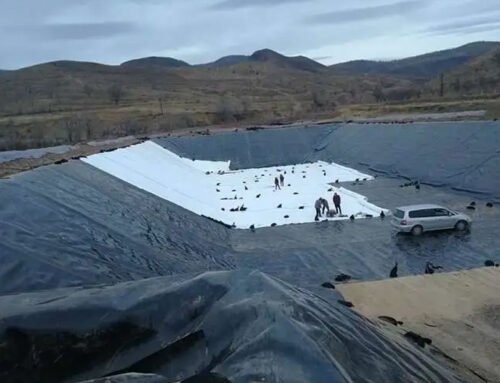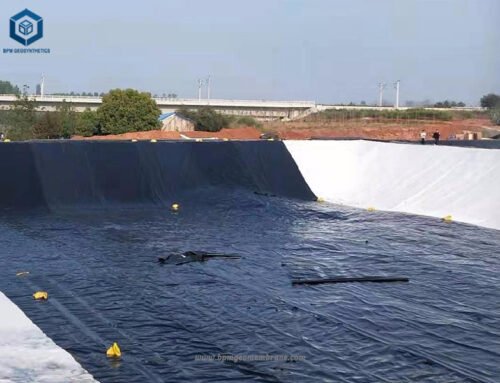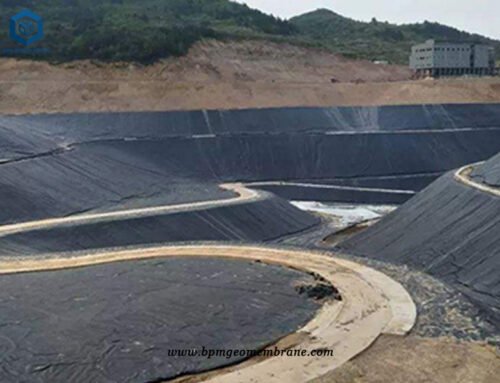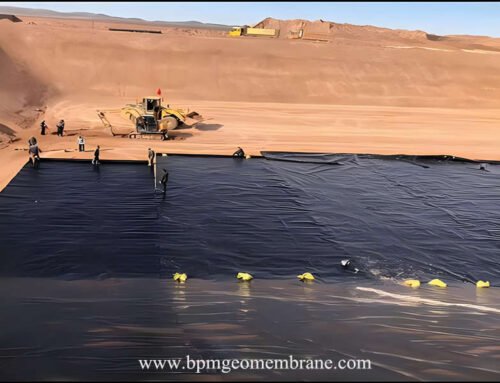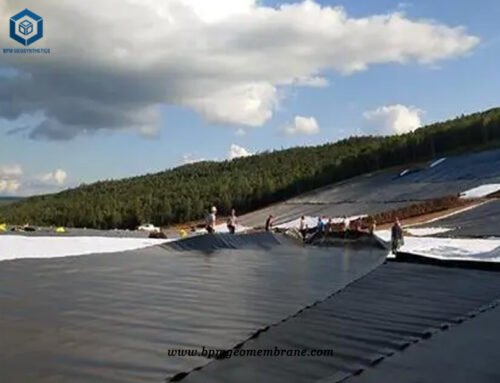Pond material liner, also known as pond liner material, is an effective waterproof geosynthetic material. The product is the most durable anti-seepage geosynthetic material with very high resistance to stress cracking and is extremely resistant to most chemicals. Pond liner material is a waterproof barrier that lines the bottom and sides of shrimp ponds or fish ponds. It is also widely used in aquaculture farm projects, freshwater fish and shrimp, mining projects, wastewater treatment, landfills and salt ponds, etc.
BPM Geomembrane offers innovative, high quality pond material liner in custom thickness and size at best facrory price,
1. What Is Pond Material Liner?
A pond material liner refers to a specialized type of geomembrane or barrier material that is used to line the bottom and sides of a pond or water containment structure. It is designed to create a barrier between the water in the pond and the surrounding soil, preventing water seepage and maintaining the desired water level.
Pond material liners are typically made from synthetic materials such as high-density polyethylene (HDPE), low-density polyethylene (LDPE), polyvinyl chloride (PVC), or reinforced polyethylene (RPE). These materials are chosen for their durability, flexibility, and resistance to chemicals, UV radiation, and punctures.


2. What Are Benifits of Pond Material Liner for Aquaculture Farm in Malaysia
2.1 High Strength
Pond material liners, such as HDPE liners, exhibit high tensile strength, with yield strengths of up to 17kn/m and break strengths of up to 33kn/m. They also have good ductility, with elongation at yield ranging from 13% to 16% and elongation at break ranging from 700% to 800%. This strength and flexibility make the aquaculture system safer and more durable, especially in areas where the floor and sides of ponds need to withstand pressure.
2.2 Improved Water Quality
Using pond material liners helps maintain high-quality water in aquaculture ponds. Clean and safe water resources are becoming increasingly scarce and expensive, and the use of geomembrane liners prevents groundwater pollution and ensures the safety and cleanliness of the water in the ponds. This leads to healthier aquatic organisms and reduces the risk of diseases, resulting in improved productivity and reduced maintenance costs.
2.3 Edible Grade
Pond material liners, like BPM HDPE liners, are produced in ISO-tested environments and meet food-grade standards. They are resistant to the invasion and growth of microorganisms, and their surfaces can be easily cleaned, disinfected, and reused within a short period. This edible-grade quality ensures the safety and hygiene of the aquaculture environment and contributes to the production of high-quality and safe seafood.
2.4 Increased Production Efficiency
The use of HDPE pond liners can significantly enhance the production efficiency of fish and shrimp breeding ponds. With reduced downtime between cycles, aquaculture farms can have more production cycles per year, allowing for higher stocking densities and increased yields. Additionally, higher mechanical aeration rates made possible by the use of pond liners enable higher tillage intensity and further contribute to improved productivity and profitability.
Malaysian farmers can benefit from enhanced durability, improved water quality, compliance with food-grade standards, and increased production efficiency with the help of pond material liners in aquaculture farms, . These advantages contribute to the sustainability and success of aquaculture operations.
3. How to Right Choose HDPE Pond Material Liner for Aquaculture?
3.1 Thickness
Determine the appropriate thickness of the HDPE liner based on the specific requirements of your aquaculture project. Thicker liners offer better durability and resistance to punctures, making them suitable for applications where the pond may be exposed to sharp objects or heavy usage.
3.2 Material Quality
Ensure that the HDPE liner you choose is of high quality and meets industry standards. Look for liners that are manufactured from virgin resin, as they tend to have better strength and longevity compared to recycled materials.
3.3 Chemical Compatibility
Consider the compatibility of the HDPE liner material with the water and chemicals used in your aquaculture system. The liner should be resistant to the specific chemicals, fertilizers, and disinfectants that will come into contact with it. Verify that the liner is designed to withstand the potential chemical exposure in your specific aquaculture setup.
3.4 Installation Ease
Consider the ease of installation for the HDPE liner. Some liners may require professional installation, while others can be installed by the aquaculture operator. Choose a liner that suits your installation capabilities and preferences.
3.5 Budget
Determine your budget for the aquaculture project and find an HDPE liner that fits within that range. While cost is a factor, prioritize the quality and suitability of the liner for your specific aquaculture needs.


4. Case Study of BPM Pond Material Liner for Aquaculture Farm in Malaysia
A customer in Malaysia contacted BPM through the Google Geomembrane website, inquiring about the price of HDPE pond liners for an aquaculture farm project. After understanding the customer’s requirements for acid and alkali resistance, corrosion resistance, and long lifespan, BPM recommended 0.75mm and 1mm thick HDPE pond liners based on their 11 years of exporting experience.
BPM recommended ASTM standard geomembranes to effectively isolate soil pollution from the pond. The thickness of the HDPE pond liner was chosen based on experience, as thicker liners tend to have a longer service life. The customer accepted the samples and expressed a preference for the 1.0mm HDPE pond liner to reduce future maintenance costs. BPM provided the customer with the HDPE pond liner sample, TRI test certificate, and examples of previous geomembrane projects.
The fish pond liner samples arrived in Malaysia within a week, and the customer was highly satisfied with the quality. To further deepen their understanding of the products, the customer requested a video factory inspection. BPM promptly provided a detailed on-site video, showcasing the complete production process from raw materials to loading. The customer appreciated this demonstration and acknowledged the professionalism of BPM in manufacturing HDPE pond liners.
5. About BPM Geomembrane
BPM Geomembrane has been specializing in delivering one stop geosynthetics products and solutions to worldwide customers since its foundation in 2007. BPM is not only manufacturing best quality geosynthetic products but also providing professional design and installation service. OEM, ODM, custom development and fabrication are also available.
If you have any questions or inquiries, please contact us.

